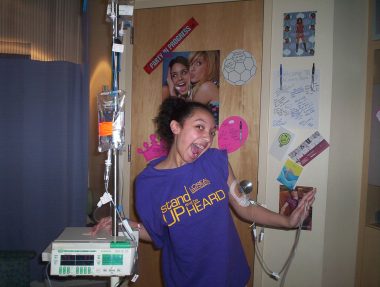Healthcare and Fashion: Send In the Gowns

If you plan on dressing like a doctor or a nurse this Halloween, you already know what to wear: a long white coat, scrubs, or an old-school nurse cap. Costuming a patient for a television show is easy, too. Simply put them in a hospital gown and have them sport an IV pole.
Needless to say, fashion is rarely associated with health. Yet, it has an enormous impact on the everyday life of chronically ill patients. Let’s break it down:
Inpatient clothing
Patients that reside in the hospital time and again are known as frequent flyers. If you’re familiar with movies such as “Five Feet Apart,” which is based on the novel by my friend Rachael Lippincott, you’ll notice that long-term patients mostly wear pajamas.
Pajamas brought me comfort in the hospital. They’re far less sterile than hospital gowns, and they made me feel more at home. They also gave me the opportunity to show off my style! SpongeBob pants pair beautifully with Great Strides T-shirts.
Here’s a gentle reminder to bring a wide array of pajamas to the hospital. You never know if your room temperature will be 20 or 100 F.
On the other hand, gowns are very helpful when you’re in the ICU, prepping for surgery, or too sick to change. There were times when I didn’t have the energy to go to the bathroom, so a sponge bath and a snap-on gown made everyone’s life easier. Some units require access to your entire body for IV access, ECG lead stickers, and bathing. Just make sure you advocate for a gown in your size. Otherwise, the entire unit will get a peek at your birthday suit.

Nicole Kohr during a tuneup at Robert Wood Johnson University Hospital in 2007. (Photo by Nicole Kohr)
Outpatient clothing
Only recently are companies becoming aware of the divide between abled and disabled clothing and how it affects us in everyday life.
When I had my feeding tube, shirts felt like the enemy. No matter how much I covered it, the device would make itself known by protruding from beneath my shirt like a faucet. Buttons were a tad better, but inevitably left a wet spot on all of my favorite tops. Leaking bellies are gross, inconvenient, and do not pair well with pastels.
Chronic illness makes fashion challenging. When you need a hole for your tubing, you’re forced to cut your clothes. You’re dependent on a range of stretchy outfits because your steroids make you gain two pant sizes.
Dressing yourself during an already burdensome lifestyle should not be exhausting, it should be fun!
Hair, shoes, and accessories
Wigs, orthopedics, and stools … oh my!
Quite a few companies have assisted with my accessory needs. I loved my pink vest. Funky memory foam shoes are a lifesaver if you’re a young osteoporosis or arthritis patient like me. I’ve never dabbled in wigs, but I would have if my hair loss journey continued.
Lightweight masks and cover-ups are a must if you faint in the sun, but I suggest buying a cute pattern. My lightweight wheelchair was black and realistic, but there were times when I longed for a pink seat. Accessible doesn’t have to mean boring.
The art of fashion
I’ve watched every season of “America’s Next Top Model” and “Project Runway.” In doing so, I’ve learned that fashion is about expressing yourself, but the industry can be biased.
I’ve had my share of self-esteem issues due to clothing. I wish more shirts had the ability to hide sweat stains. It would be cool if pants could disguise odor. What if snaps and string allowed you to change the fit of a shirt — similar to a hospital gown? Regardless, including accessible looks on billboards and magazines will help bridge the gap between the real and the photoshopped worlds we’re accustomed to seeing.
The ballad “Send In the Clowns” from the Broadway classic “Little Night Music” discusses the ironies of an ill-timed affair. I didn’t understand the lyrics as a child, but one phrase struck me despite that:
“Finally knowing the one that I wanted was yours. Making my entrance again with my usual flair.”
I assumed it meant, “You wish you could wear that girl’s shirt, but you’ll have to wear your own flair.” While my interpretation was sophomoric, it has served as a reminder all these years!
Healthcare has some of the most iconic looks. Why not be inspired? Patients don’t have to wear an ill-fitting gown. Perhaps tomorrow, I’ll wear a long white coat.

Nicole and her mom pause for a photo before a bronchoscopy at the University of Pennsylvania in 2020. (Photo by Nicole Kohr)
Come back next Thursday to read more of my story.
***
Note: Cystic Fibrosis News Today is strictly a news and information website about the disease. It does not provide medical advice, diagnosis, or treatment. This content is not intended to be a substitute for professional medical advice, diagnosis, or treatment. Always seek the advice of your physician or other qualified health provider with any questions you may have regarding a medical condition. Never disregard professional medical advice or delay in seeking it because of something you have read on this website. The opinions expressed in this column are not those of Cystic Fibrosis News Today, or its parent company, Bionews, and are intended to spark discussion about issues pertaining to cystic fibrosis.









Leave a comment
Fill in the required fields to post. Your email address will not be published.